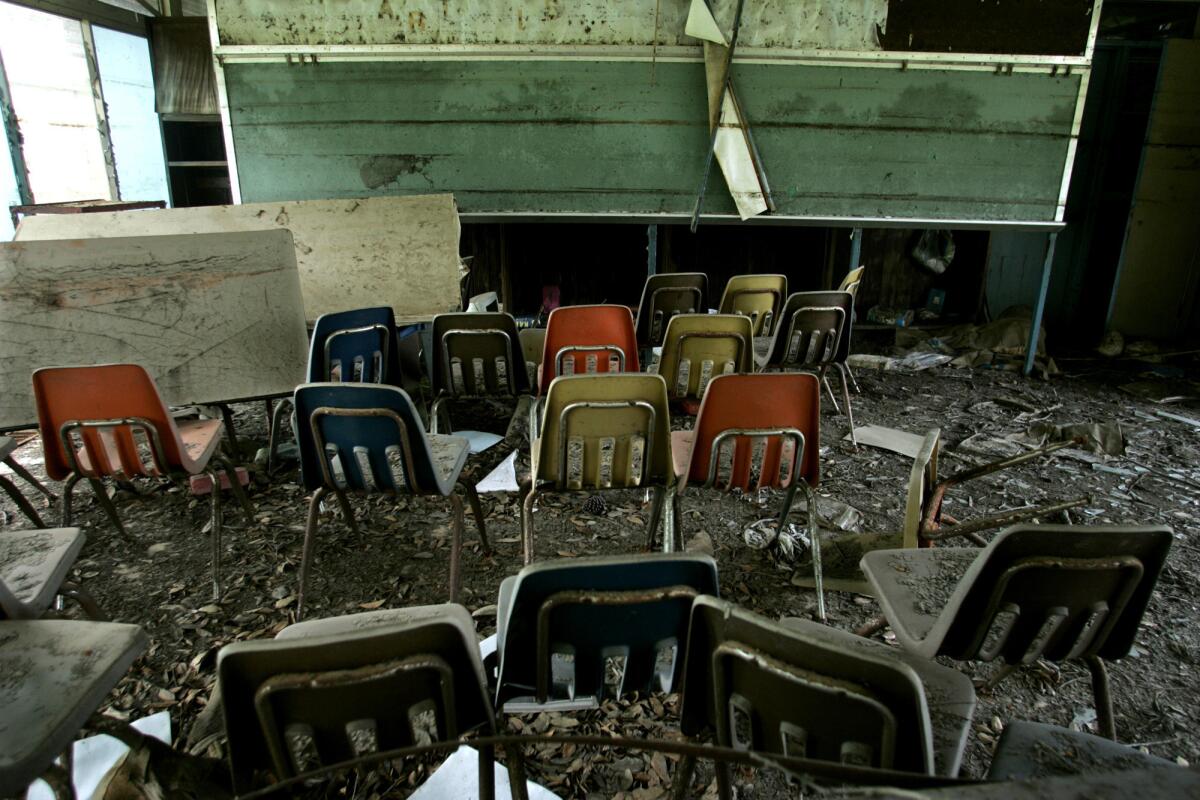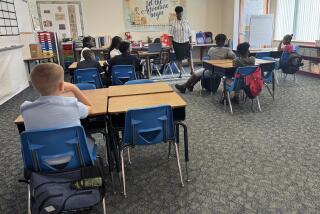The best New Orleans schools stories for #Katrina10

St. Frances Xavier Cabrini School, shown in 2006, was among many New Orleans schools devastated by Hurricane Katrina.
This week marks the tenth anniversary of Hurricane Katrina in New Orleans.
Across the country, media outlets are publishing deep dives into the changes that the city has seen over the last decade. Among the most controversial was the decision to wipe out the public school system and replace it with charters. The fate of charter schools in New Orleans has ramifications for schools here in Los Angeles, as parents increasingly turn to these privately run but publicly funded alternatives to the Los Angeles Unified School District.
Here is our roundup of the best coverage of post-Katrina schools and the young people who grew up in New Orleansâ educational experiment.
It is by no means a complete list, and we welcome your suggestions.
New York Times: 10 years after Katrina
The New York Times published a long, and beautifully constructed, read on the changes in the last 10 years, encompassing business, housing, racial demographics and, of course, education. âThere is perhaps no topic of the last 10 years as polarizing: a piecemeal, state-run experiment begun before Katrina that took off afterward as among the most radical education overhauls in the country,â wrote Campbell Robertson and Richard Fausset.
Education Next: Studying the Schools
Before the storm, Tulane University professor Douglas Harris wrote, New Orleansâ âstudent test scores made it the second-lowest-ranked district in the second-lowest-ranked state in the country.â In this new study, Harris found that New Orleans schools had improved since that low point, according to several metrics. However, he didnât attribute all of the growth to the influx of charter schools.
NPR: New Orleans Schools, 10 Years After Katrina: Beacon or Warning?
NPR education reporter Anya Kamenetz parsed through Harrisâ research and wrote of her own visit back to New Orleans with her parents after the storm. The charts in this story illustrated progress and the difference in perception of school improvement between white and black parents in New Orleans.
Marketplace Morning Report series:
Charters transform New Orleans schools, and teachers
In the first installment of Marketplaceâs series on changes to the New Orleans education system, David Brancaccio talked to a former student, an education researcher and two teachers who were affected by the charter conversion.
From the story:
âHolley Bendtsen, a 10th-grade teacher at Landry-Walker high school with decades of experience, sees herself as a career educator, in contrast to this new, more transient teacher population.
â âThey come in and they are working so hard, but itâs all so rough,â Bendtsen says. âThereâs no way you can prepare anybody for it, you just have to live it.â Furthermore, many good veteran teachers who may have stayed in the New Orleans school system left the city. She says one of her former colleagues is now a school superintendent back East, another is a teacher of the year several times over in North Carolina.â
Charting New Orleansâ charter school experiment
For story No. 2, Brancaccio talked to educators and a researcher about how the charter conversion turned out. All had different answers. Hereâs what 26-year-old New Orleans teacher Phil Dorn, a white Teach for America teacher from New York, told Marketplace about his experience:
âMost of the teachers that go into TFA, they donât look like the students that they are serving,â he said. âThere isnât this push for teachers to really understand the community that they are working in. And itâs difficult, when you are working from 6 a.m. to 11 p.m., you donât really have time to engage with the community in the way that you would.â
One Katrina kid growing up after the flood
Finally, Brancaccio talked to one student he had met when covering Katrinaâs aftermath 10 years ago. Domonick Foy, now 21, had this to say about school the year after the hurricane:
âI felt like they did as much as they were able to do, but as far as us as students, it wasnât fair to us. Itâs not like we really learned anything,â Domonick recalled of his seventh-grade year. âWe didnât have textbooks at all that year.â
The Seventy Four: New Orleansâ school destruction, in photos
Campbell Brownâs new education website, The Seventy Four, published a timeline of photos showing the destruction that Katrina caused to the cityâs schools, the disarray that remained even two years later, and more recent photos of the cityâs students and schools.
National Geographic: On lead poisoning in New Orleans
Schools arenât the only places kids had problems in New Orleans. The cityâs soil has always had high lead levels. Though lead levels actually decreased after the hurricane, many newcomers to the city didnât know their children were at risk to begin with.
The Hechinger Report: Katrina might as well have hit New Orleans a day ago if youâre young, male and black
Glenn Sullivan wrote of his educational trajectory â he left New Orleans to stay with family in Houston after Katrina in fifth grade, entered an unfamiliar school system in which he was behind, then returned to the new charter system in his hometown three years later. He described Live Oak Elementary, where he finished eighth grade:
âThere was an eerie prison-like energy in the dilapidated building. Students were searched at the entrance and classes were constantly interrupted to line students up in the hallways and search for stolen items. Substitute teachers who could not help with the material often taught required classes.â
He wrote that tourism is growing in New Orleans, but the city must work harder to educate and offer white-collar, middle class jobs to students of color.
Education Week: The re-education of New Orleans
A team of reporters produced a package of six stories covering the changes to New Orleans schools over the last decade. They used the space to delve deeper than many of the organizations who produced just one story about the changes. These are the stories of families â parentsâ difficulties navigating school choice, the methods charters use to exclude students they donât want, the son who is going to college from a New Orleans charter education, the mother and daughter who left and never came back. Particularly notable are the data showing how Katrina evacuees performed academically in other districts.
Washington Post: The last time I saw my mother
Weâll leave you with this essay from a Washington Post reporter who was 13 when Katrina hit. In talking about the effects of disasters on children, itâs easy to focus on schools and policy, on big-picture change and the impact that New Orleans school reform can have on the country. This is a reminder that the hurricane snatched away mothers and fathers and siblings, that the young people of New Orleans suffered a serious tragedy outside the classroom.
âSome city residents say Katrinaâs aftermath brought both good and bad things to New Orleans. I will never view as positive anything to come out of Katrina and the flood,â Wilborn P. Nobles III wrote.
Reach Sonali Kohli on Twitter @sonali_kohli or by email at [email protected].
More to Read
Sign up for Essential California
The most important California stories and recommendations in your inbox every morning.
You may occasionally receive promotional content from the Los Angeles Times.










